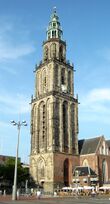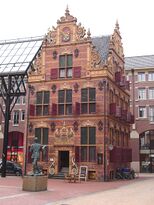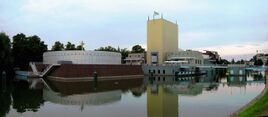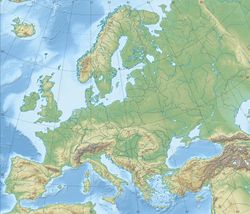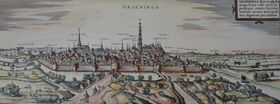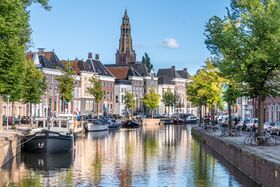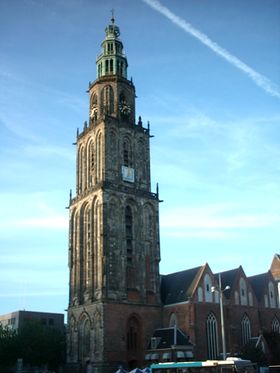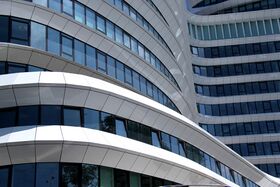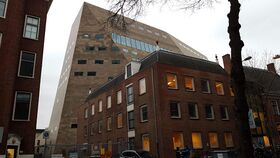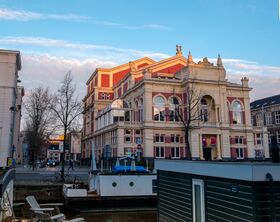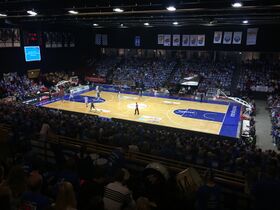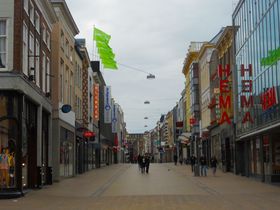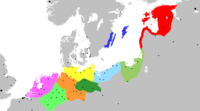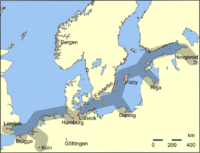خروننغن
خروننگن
Grunn(en) (Gronings) Groningen | |
|---|---|
Gasunie building Grote Markt Square Groningen City Theater Aa Church/Korenbeurs | |
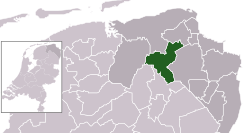 Location in Groningen | |
| الإحداثيات: 53°13′08″N 06°34′03″E / 53.21889°N 6.56750°E | |
| Country | |
| Province | Groningen |
| City Hall | Groningen City Hall |
| الحكومة | |
| • الكيان | Municipal council |
| • Mayor | Koen Schuiling (VVD) |
| المساحة | |
| • Municipality | 83٫75 كم² (32٫34 ميل²) |
| • البر | 78٫05 كم² (30٫14 ميل²) |
| • الماء | 5٫70 كم² (2٫20 ميل²) |
| المنسوب | 7 m (23 ft) |
| أعلى منسوب | 12 m (39 ft) |
| التعداد (January 1st 2023) | |
| • Municipality | 238 147[1] |
| • الكثافة | 2٬572/km2 (6٬660/sq mi) |
| • Urban | 216٬655 |
| • العمرانية | 360٬748 |
| صفة المواطن | Groninger, Stadjer |
| منطقة التوقيت | UTC+1 (CET) |
| • الصيف (التوقيت الصيفي) | UTC+2 (CEST) |
| Postcode | 9700–9747 |
| Area code | 050 |
| الموقع الإلكتروني | groningen |
| Click on the map for a fullscreen view | |
خروننگن ( Groningen ؛ /ˈɡroʊnɪŋən/, also UK /ˈɡrɒnʔ/, الأمريكي /ˈxroʊnʔ/,[5][6][7] هولندية: [ˈɣroːnɪŋə(n)] (![]() استمع); قالب:Lang-gos) is the main municipality as well as the capital city of the eponymous province in the Netherlands. It is the largest city in the north of the Netherlands and has 231,037 inhabitants (31 January 2019) on a total area of 180.21 km2 (69.58 sq mi), and land area of 168.93 km2 (65.22 sq mi) with a population density of 1,367 per km2 (3,540 per square mile). It merged with Ten Boer and Haren municipalities in 1 January 2019. The Groningen-Assen metropolitan area has about half a million inhabitants. Groningen is an old city (more than 950 years) and was the regional power of the north of the Netherlands, a semi-independent city-state and member of the German Hanseatic League. Groningen is a university city, with an estimated 32,700 students at the University of Groningen (1 October 2019), and an estimated 28,432 at the Hanze University of Applied Sciences (1 February 2020).[8][9]
استمع); قالب:Lang-gos) is the main municipality as well as the capital city of the eponymous province in the Netherlands. It is the largest city in the north of the Netherlands and has 231,037 inhabitants (31 January 2019) on a total area of 180.21 km2 (69.58 sq mi), and land area of 168.93 km2 (65.22 sq mi) with a population density of 1,367 per km2 (3,540 per square mile). It merged with Ten Boer and Haren municipalities in 1 January 2019. The Groningen-Assen metropolitan area has about half a million inhabitants. Groningen is an old city (more than 950 years) and was the regional power of the north of the Netherlands, a semi-independent city-state and member of the German Hanseatic League. Groningen is a university city, with an estimated 32,700 students at the University of Groningen (1 October 2019), and an estimated 28,432 at the Hanze University of Applied Sciences (1 February 2020).[8][9]
التاريخ
The city was founded at the northernmost point of the Hondsrug area. The oldest document referring to Groningen's existence dates from 1040. However, the city already existed long before then: the oldest archaeological traces found are believed to stem from the years 3950–3720 BC, although the first major settlement in Groningen has been traced back to the 3rd century AD.
In the 13th century, when Groningen was an important trade centre, its inhabitants built a city wall to underline its authority. The city had a strong influence on the surrounding lands and made its Gronings dialect a common tongue. The most influential period of the city was the end of the 15th century, when the nearby province of Friesland was administered from Groningen. During these years, the Martinitoren, then 127 metres (417 feet) tall, was built; it loomed over the city. The city's independence ended in 1536, when it chose to accept Emperor Charles V, the Habsburg ruler of the other Netherlands, as its overlord.
In 1594, Groningen, until then held by Spain, was captured by a Dutch and English force led by Maurice of Nassau. Soon afterwards the city and the province joined the Republic of the Seven United Provinces.
In 1614, the University of Groningen was founded, initially only for religious education. In the same period the city expanded rapidly and a new city wall was built. That same city wall was tested during the Third Anglo-Dutch War in 1672, when the city was attacked fiercely by the bishop of Münster, Bernhard von Galen. The city walls resisted, an event that is still celebrated with music and fireworks on 28 August (as "Gronings Ontzet" or "Bommen Berend").
The city did not escape the devastation of World War II. In particular, the main square, the Grote Markt, was largely destroyed in April 1945 in the Battle of Groningen. However, the Martinitoren, its church, the Goudkantoor, and the city hall were not damaged. The battle lasted several days.
الجغرافيا
المناخ
Groningen has an oceanic temperate climate, like all of the Netherlands, although slightly colder in winter than other major cities in the Netherlands due to its northeasterly position. Weather is influenced by the North Sea to the north-west and its prevailing north-western winds and gales.
Summers are somewhat warm and humid. Temperatures of 30 °C (86 °F) or higher occur sporadically; the average daytime high is around 22 °C (72 °F). Very rainy periods are common, especially in spring and summer. Average annual precipitation is about 800 mm (31 in). Annual sunshine hours vary, but are usually below 1600 hours, giving much cloud cover similar to most of the Netherlands. Climate in this area has mild differences between highs and lows, and there is adequate rainfall year-round. The Köppen Climate Classification subtype for this climate is "Cfb". (Marine West Coast Climate/Oceanic climate).[10]
Winters are cool: on average above freezing, although frosts are common during spells of easterly wind from Germany, Russia and even Siberia. Night-time temperatures of −10 °C (14 °F) or lower are not uncommon during cold winter periods. The lowest temperature ever recorded is −26.8 °C (−16.2 °F) on 16 February 1956. Snow often falls, but rarely stays long due to warmer daytime temperatures, although white snowy days happen every winter. قالب:Groningen weatherbox
النمو السكاني
The municipality of Groningen has grown rapidly. In 1968 it expanded by mergers with Hoogkerk and Noorddijk, and in 2019 it merged with Haren and Ten Boer. All historical data are for the original city limits, excluding Hoogkerk, Noorddijk, Haren and Ten Boer.
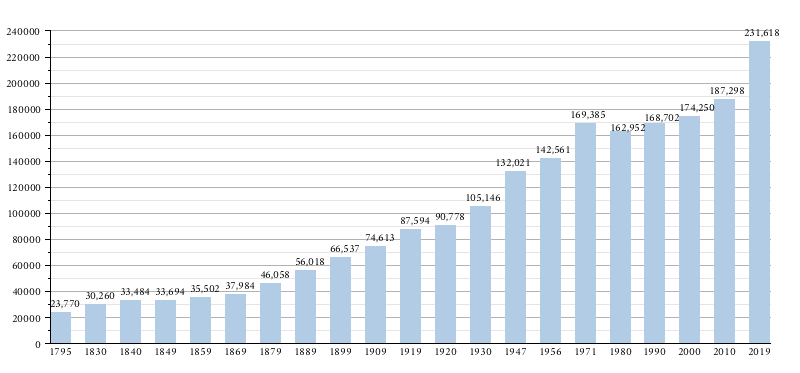
الاقتصاد
Until recently, there were two large sugar refineries within the city boundaries. The Suiker Unie plant was originally outside Groningen, but it was completely swallowed by the expansion of the city. After a campaign to close the factory, it was finally shut down in 2008/2009. Before closing down, its sugar production amounted to 250,000 tonnes of beet sugar, with 250 employees (2005 figures). The only remaining sugar factory is CSM Vierverlaten in Hoogkerk, which produces 235,000 tonnes of beet sugar, with 283 employees.
Well known companies from Groningen are publishing company Noordhoff Uitgevers, tobacco company Royal Theodorus Niemeyer, health insurance company Menzis, distillery Hooghoudt, and natural gas companies GasUnie and GasTerra. There is an increased focus on business services; specifically IT, life sciences, tourism, energy, and environment. In addition, the hotel and catering industry forms a significant part of the economy of Groningen.
الثقافة
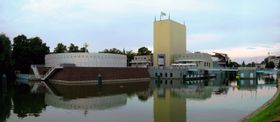
The city is nationally known as the "Metropolis of the North" and as "Martinistad" referring to the tower of the Martinitoren, named after its patron saint Martin of Tours.
Although Groningen is not a very large city, it does have an important role as the main urban centre of this part of the country, particularly in the fields of music and other arts, education, and business. The large number of students living in Groningen also contributes to a diverse cultural scene for a city of its size.
Since 2016 Groningen is host of the International Cycling Film Festival, an annual film festival for bicycle related films. It takes place in the art house cinema of the old Roman Catholic Hospital.
المتاحف
The most famous museum in Groningen is the Groninger Museum. Its new building, designed by Alessandro Mendini, has transformed the museum into one of the most modern and innovative of its kind in the Netherlands. In addition, the city has a maritime museum, a university museum, a comics museum and a graphics museum. Groningen is also the home of Noorderlicht, an international photographic platform that runs a photo gallery and organizes an international photo festival.In 2019, the Forum Groningen opened. This cultural centrum consists of a museum, art cinema, library, bars, rooftop terrace and tourist information office.
المسارح والموسيقى
Groningen has a city theatre (Stadsschouwburg), located on the Turfsingel; a big theatre and concert venue called Martini Plaza; and another major cultural venue on the Trompsingel, called the Oosterpoort. Vera is located on the Oosterstraat, the Grand Theatre on the Grote Markt, and Simplon on the Boterdiep. Several cafés feature live music, a few of which specialize in jazz music, including Jazzcafe De Spieghel on the Peperstraat. The jazz music students from the Prince Claus Conservatoire have been known to hold regular jam sessions in cafés such as Peter Pan on the Voor Het Voormalige Klein Poortje and café De Smederij on the Tuinstraat 2–4. Groningen is also the host city for Eurosonic Noorderslag, an annual music showcase event for over a hundred bands from all over Europe.
الحياة الليلية
Groningen's nightlife depends largely on its student population. Its cultural scene is vibrant and remarkable for a city its size. In particular, the Grote Markt, the Vismarkt, the Poelestraat and Peperstraat are crowded every night of the week, and most bars do not close until 5 in the morning. Between 2005 and 2007, Groningen was elected "best city centre" of the Netherlands.[11] Groningen has a red-light district, called Nieuwstad. A second one in the A-kwartier (an area) has been closed as of late 2015. Both areas are in or near the city centre.
الرياضة
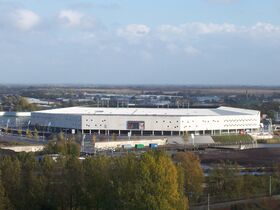
The local football club is FC Groningen, founded in 1971. As at the 2018–19 season they play in the Dutch top football league, the Eredivisie. Winners of the KNVB cup in 2014/15, their best league result was in the Eredivisie in the 1990–91 season, when they finished third. Their current stadium, which opened in January 2006, is the Hitachi Capital Mobility Stadion (before the 2015–2016 season it was called the Euroborg stadium and it was called Noordlease Stadion from 2016 to 2018) which has 22,550 seats.[12]
American sports are fairly popular in Groningen; it has American football, baseball, and basketball clubs. Groningen's professional basketball club, Donar, play in the highest professional league, the Dutch Basketball League, and have won the national championship seven times. The Groningen Giants are the American Football Team of Groningen. They play in the Dutch Eredivisie and are considered the "Kings of the North".
One of the biggest running events of the country, the 4 Miles of Groningen, takes place in Groningen every year on the second Sunday in October.
The 2002 Giro d'Italia started in Groningen, including the prologue and the start of the 1st stage. The city also hosted the start and finish of the 5th stage of the 2013 Energiewacht Tour.
التعليم
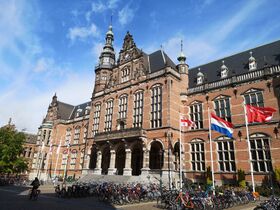
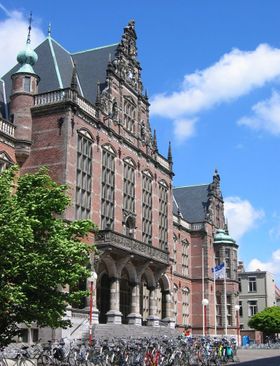
The University of Groningen (in Dutch: Rijksuniversiteit Groningen) has a rich academic tradition that dates back to 1614. After the University of Leiden, it is the second oldest Dutch university. The university educated the first female student, Aletta Jacobs, the first Dutch national astronaut, Wubbo Ockels, the first president of the European Central Bank, Wim Duisenberg and two Nobel prize winners, Heike Kamerlingh Onnes and Ben Feringa. 200,000 people were either students, teachers or researchers at the university. Groningen University hosts about 31,000 students of whom about 22% are international.[13]
The Hanze university of applied sciences (in Dutch: Hanzehogeschool Groningen) was founded in 1986 and is more focused on the practical application of knowledge, offering bachelor and master courses in subjects like Electrical and Electronic Engineering, Communication & Multimedia Design, Renewable Energy and more.[14] While only 8,1% of students are international, Hanze hosts more than 28,000 students and is one of the biggest University of Applied Sciences in the Netherlands.[15]
Having about 59,000 students total and about 200,000 inhabitants, the city of Groningen has one of the highest density of students in the nation, approximately 25%.
السياسة
As at January 2019, the Groningen municipality council has 45 members. GroenLinks is the largest party on the council with 11 seats. The PvdA holds 6 seats. Both D66 and the Socialist Party have 5 seats. The VVD has 4 seats, while ChristenUnie and the Party for the Animals each have 3 seats. Christian Democratic Appeal, 100% Groningen and Stadspartij have 2 seats each; the 2 remaining seats are divided between Student en Stad and the right party Party for Freedom.[16][17]
العلاقات الدولية
Groningen is twinned with the following:[18]
|
النقل
الدراجات والمشي
Groningen has been called the "World Cycling City" because 57% of journeys within the city are made by bicycle.[21] Like most Dutch cities, Groningen is well adapted to the large number of cyclists. A large network of bike paths makes it convenient to cycle to various destinations. In 2000, Groningen was chosen as Fietsstad 2002 — top BikeCity of the Netherlands for 2002.
The city is very much adapted to the wishes of those who want to get around without a car, as it has an extensive network of segregated cycle-paths, good public transport, and a large pedestrianised zone in the city centre. The transformation of the historic centre into a pedestrian priority zone enables and invites walking and biking. This is achieved by applying the principle of "filtered permeability". It means that the network configuration favours active transportation and selectively "filters out" the car by reducing the number of streets that run through the centre. While certain streets are discontinuous for cars, they connect to a network of pedestrian and bike paths which permeate the entire centre. In addition, these paths go through public squares and open spaces, increasing the enjoyment of the trip (see image). The logic of filtering a mode of transport is fully expressed in a comprehensive model for laying out neighbourhoods and districts – the fused grid.
المواصلات العامة
القطارات[22]
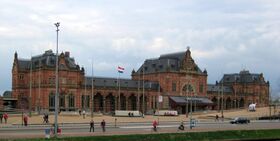
The Station of Groningen or Hoofdstation as the locals call it, has regular services to most of the major cities in the Netherlands. The city's remaining two railway stations are Europapark and Noord.
Groningen has six railway routes:
- Gronigen - Delfzijl
- Groningen - Roodeschool / Eemshaven
- Groningen - Leeuwarden
- Groningen - Veendam
- Groningen - Weener / Leer
- Groningen - Meppel / Zwolle
On those six routes, ten lines stop at:
- Groningen - Groningen North - Sauwerd - Bedum - Stedum - Loppersum - Appingedam - Delfzijl West - Delfzijl
- Groningen - Groningen North - Sauwerd - Winsum - Baflo - Warffum - Usquert - Uithuizen - Uithuizermeeden - Roodeschool - (Low Service) Eemshaven
- Groningen - Zuidhorn - Grijpskerk - Buitenpost - De Westereen - Feanwâlden - Hurdegaryp - Leeuwarden Camminghaburen - Leewarden
- Groningen - Buitenpost - Leewarden
- Groningen - Groningen Europapark - Kropswolde - Martenshoek - Hoogezand-Sappemeer - Sappemeer oost - Zuidbroek - Veendam
- Groningen - Groningen Europapark - Kropswolde - Martenshoek - Hoogezand-Sappemeer - Sappemeer oost - Zuidbroek - Scheemda - Winschoten - (Lower service) Bad Nieuweschans - Weener - (Due to a broken bridge, the does noe go on to Leer. Take a bus form Groningen or Weener)
- Groningen - Groningen Europapark - Haren - Assen - Beilen - Hoogeveen - Meppel - Zwolle
- Groningen - Assen - Zwolle - Amersfoort Centraal - Utrecht Centraal - Gouda - Rotterdam Alexander - Rotterdam Centraal
- Groningen - Assen - Zwolle - Lelystad Centrum - Almere Centrum - Amsterdam South - Schiphol - Leiden Centraal - Den Haag Centraal / The Hague Centraal
الحافلات[23]
Direct bus routes Groningen and Bremen, Hamburg, Berlin, and Munich are also available.
السيارة
The A28 motorway connects the city of Groningen to Utrecht (via Assen, Zwolle and Amersfoort). The A7 motorway connects Groningen to Friesland and Zaandam (West) and Winschoten and Leer (East).
المصار[24]
Groningen Airport Eelde is located 10 kilometres (6 miles) south of the centre of Groningen, with scheduled services to Guernsey, Gran Canaria, Antalya, Crete, Mallorca & Bodrum.
العبـّارة
A ferry service is being proposed between The Eemshaven and Rosyth, Scotland.
أبرز السكان
- Abel Janszoon Tasman (1603–1659), explorer, seafarer, merchant for the Dutch East India Company
- Albert Dominicus Trip van Zoudtlandt (1776–1835), lieutenant-general at the Battle of Waterloo
- Heike Kamerlingh Onnes (1853-1926), physicist, Nobel laureate
- Dirk Jan de Geer (1870–1960), statesman and Dutch Prime Minister (1926–29, 1939–40), advocated peace settlement between the Netherlands and Nazi Germany in 1940
- A.W.L. Tjarda van Starkenborgh Stachouwer (1888–1978), last colonial Governor-General of the Netherlands East Indies
- Michel Velleman (1895–1943), Jewish magician
- Jan Wolthuis (1903–1983), lawyer and collaborator, active in far-right politics after WWII
- Pete Hoekstra (born 1953), United States ambassador to the Netherlands, former Republican member of Congress representing Michigan's 2nd congressional district
- Gerard Kemkers (born 1967), speed skating bronze medalist at 1988 Winter Olympics
- Bauke Mollema (born 1986), cyclist
- Kim Feenstra (born 1985), model
انظر أيضاً
- Groningen (province)
- Sint Geertruidsgasthuis, a hofje in Groningen.
الهامش
- ^ "CBS Statline kerncijfers". cbs.nl.
- ^ "Burgemeester" [Mayor] (in الهولندية). Gemeente Groningen. Archived from the original on 22 December 2013. Retrieved 22 December 2013.
- ^ "Kerncijfers wijken en buurten" [Key figures for neighbourhoods]. CBS Statline (in Dutch). CBS. 2 July 2013. Retrieved 12 March 2014.
{{cite web}}: CS1 maint: unrecognized language (link) - ^ "Postcodetool for 9712HW". Actueel Hoogtebestand Nederland (in الهولندية). Het Waterschapshuis. Archived from the original on 21 September 2013. Retrieved 22 December 2013.
- ^ "Groningen". The American Heritage Dictionary of the English Language (5th ed.). HarperCollins. Retrieved 1 May 2019.
- ^ "Groningen" (US) and قالب:Cite Oxford Dictionaries
- ^ قالب:Cite Merriam-Webster
- ^ "Facts & Figures". Hanze University of Applied Sciences. Retrieved 4 June 2020.
- ^ "Key figures". University of Groningen (in الإنجليزية). 14 July 2004. Retrieved 4 June 2020.
- ^ Climate Summary for Groningen
- ^ "Winnaars 2005 - 2007 -- Verkiezing Beste Binnenstad" [Winners 2005 - 2007 -- Election Best City Centre] (in Dutch). debestebinnenstad.nl. Archived from the original on 19 أكتوبر 2012. Retrieved 15 فبراير 2012.
{{cite web}}: CS1 maint: unrecognized language (link) - ^ FC Groningen: Club Info
- ^ "Key figures | Facts and figures | Our position | About us | University of Groningen". www.rug.nl. Retrieved 2019-10-18.
- ^ "Programmes". www.hanze.nl (in الإنجليزية البريطانية). Retrieved 2019-10-18.
- ^ "Facts & Figures". www.hanze.nl (in الإنجليزية البريطانية). Retrieved 2019-10-18.
- ^ "Definitieve uitslag gemeenteraadsverkiezing 2018" (PDF) (in الهولندية). Gemeente Groningen. Retrieved 23 November 2018.
- ^ "Samenstelling gemeenteraad". Gemeente Gronignen.
- ^ "Groningen – Partner Cities". 2008 Gemeente Groningen, Kreupelstraat 1,9712 HW Groningen. Archived from the original on 26 سبتمبر 2007. Retrieved 8 ديسمبر 2008.
- ^ "Twin Towns – Graz Online – English Version". graz.at. Archived from the original on 8 نوفمبر 2009. Retrieved 5 يناير 2010.
- ^ "Kaliningrad – Partner Cities". 2000–2006 Kaliningrad City Hall. Archived from the original on 11 December 2008. Retrieved 8 December 2008.
- ^ "global ideas bank". globalideasbank.org. 15 October 2007. Retrieved 14 July 2009.
- ^ https://nieuws.ns.nl/spoorkaart-2020-hier-te-downloaden/
- ^ https://www.ovbureau.nl/ov-cijfers/interactieve/
- ^ https://www.groningenairport.nl/bestemmingen-overzicht
ببليوگرافيا
- Lourens, Piet; Lucassen, Jan (1997). Inwonertallen van Nederlandse steden ca. 1300–1800. Amsterdam: NEHA. ISBN 9057420082.
{{cite book}}: Invalid|ref=harv(help)
وصلات خارجية
- Official website (in هولندية)
- Pages using gadget WikiMiniAtlas
- صفحات تستخدم خطا زمنيا
- CS1 الهولندية-language sources (nl)
- CS1 الإنجليزية البريطانية-language sources (en-gb)
- Short description with empty Wikidata description
- Articles containing Gronings-language text
- Pages using multiple image with auto scaled images
- Coordinates not on Wikidata
- صفحات تستخدم جدول مستوطنة بقائمة محتملة لصفات المواطن
- Articles with hatnote templates targeting a nonexistent page
- Articles with هولندية-language sources (nl)
- خروننگن (مدينة)
- مدن هولندا
- أعضاء الرابطة الهانزية
- Municipalities of Groningen (province)
- Populated places in Groningen (province)
- Provincial capitals of the Netherlands




